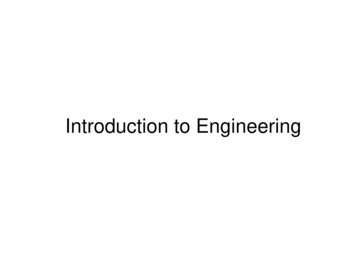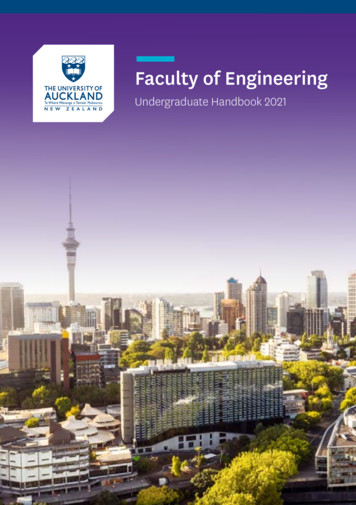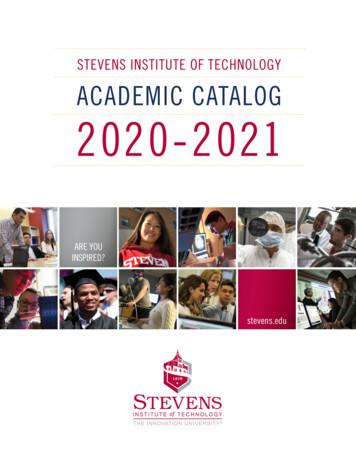Introduction To Engineering
Introduction to Engineering
Engineering Misconception―IFrom: http://www.mos.org/eie/pdf/research/Pipeline EiE evaluation 0405 final.pdf
Engineering Misconception―IIWhich of these things are examples of technology?How do you know something is technology?From: http://www.ciese.org/eofnj/docs/ResearchEiE.pdf
Engineering Misconception―IIIPlumberElectrician
Engineering Misconception―IVCarpenterAuto Mechanic
Engineering Misconception―VTrain OperatorPrinting Press Operator
Engineering Misconception―VIPC TechnicianBuilding Supervisor/Handyman
Engineering Misconception―VIIWelderMachinist
Engineering Misconception―VIIITradeProfession
Science v/s Engineering Science:– Investigation, understanding, and discovery ofnature, its composition, and its behavior (i.e., “lawsof nature”)– Why– Build (experiments, tools, devices, etc.) to learn Engineering:– Manipulating the forces of nature to advancehumanity– How– Learn to build (products and services useful forhumans)
What is Engineering―I Engineering: Latin root, ingeniere, to design or todevise Engineering is design under constraint device, component, subsystem, system such asAirplaneHeart ValveEngineSkyscraperMicrocontrollerAir ConditionerProstheticsBridge
What is Engineering―II Successful engineering design improvesquality of life while working withintechnical, economic, business, societal,and ethical constraints. Technology: Outcome of engineering
Engineering Defined―I Profession in which knowledge of mathand natural sciences, gained by study,experience, and practice, is applied withjudgment to develop ways to use,economically, the materials and forces ofnature for the benefit of mankind.– Accreditation Board for Engineering andTechnology (ABET)
Engineering Defined―II Profession Math and natural sciences Knowledge acquired by study, experience, andprofessional practice Knowledge applied with judgment Attention must be paid to constraints (economic,materials, forces of nature) Benefit of mankind Not based solely on trial, error, intuition
Mechanical EngineeringMachinery, Production, ManufacturingMachines & MechanismManufacturing
Mechanical EngineeringAnalysis & DesignAerodynamic Design of VehiclesCompute Aided Analysis & Design
Mechanical EngineeringEnergyWind EnergyFuel Cell
Mechanical EngineeringAir & SpaceUAVSpace Shuttle
Mechanical EngineeringSystemsUtilitiesRobotics
Civil EngineeringAnalysis & DesignFoundationStructural Analysis
Civil EngineeringConstructionBridgeTunnelSkyscraper
Civil EngineeringEnvironmentalWater Treatment
Civil EngineeringSystemsTransportationUtilities
Electrical EngineeringElectricity
Electrical EngineeringElectrical & Electronic Circuits
Electrical EngineeringMotors & GeneratorsMotorGenerator
Electrical EngineeringInstrumentsOscilloscopePower SupplyMeasurement
Electrical EngineeringRadar
Electrical EngineeringCommunication & NetworksCommunicationNetwork
Engineering Majors l reStructuralSystemsTextileTissue
What Engineers Do―I Research: Advance fieldDevelopment: Lab to marketTesting: Verify integrity, reliability, qualityDesign: Develop specs for manufacturing,construction, etc. Analysis: Use math models to aid in R&D Systems: Integrate components to producefunctioning product Manufacturing: Developplants and process to make products Construction: Build
What Engineers Do―II Facility/Plant OperationMaintenanceTechnical SupportCustomer SupportSalesConsultingManagementOthers
Why Engineering in K-12 Real-world engineering applications andexamples concretize complex math andscience concepts Students are engaged in experiential learning Students’ creativity is challenged, developed,and enhanced Students’ soft skills in communication andteam-work are developed Students are better equipped for college-levelwork and can become active participants in anincreasingly technological society
Mechanical Engineering Aerodynamic Design of Vehicles Compute Aided Analysis & Design Analysis & Design. Mechanical Engineering Wind Energy Fuel Cell Energy. Mechanical Engineering UAV Space Shuttle Air & Space. Mechanical Engineering Robotics Utilities Systems. Civil Engineering Foundation Structural Analysis Analysis & Design. Civil Engineering Bridge Skyscraper Tunnel Construction . Civil .
Materials Science and Engineering, Mechanical Engineering, Production Engineering, Chemical Engineering, Textile Engineering, Nuclear Engineering, Electrical Engineering, Civil Engineering, other related Engineering discipline Energy Resources Engineering (ERE) The students’ academic background should be: Mechanical Power Engineering, Energy .
work/products (Beading, Candles, Carving, Food Products, Soap, Weaving, etc.) ⃝I understand that if my work contains Indigenous visual representation that it is a reflection of the Indigenous culture of my native region. ⃝To the best of my knowledge, my work/products fall within Craft Council standards and expectations with respect to
Careers in Engineering Guide the brighter choice. Contents ABOUT LSBU 4–5 BUILDING SERVICES ENGINEERING 6–7 CHEMICAL AND PETROLEUM ENGINEERING 8–9 CIVIL ENGINEERING 10–11 ELECTRICAL AND ELECTRONIC ENGINEERING 12–13 MECHANICAL ENGINEERING 14–15 MECHATRONICS ENGINEERING 16–17 PRODUCT DESIGN ENGINEERING 18–19 An engineering degree is a big challenge to take on. There is no denying .
OLE MISS ENGINEERING RECOMMENDED COURSE SCHEDULES Biomedical engineering Chemical engineering Civil engineering Computer engineering Computer science Electrical engineering General engineering Geological engineering Geology Mechanical engineering Visit engineering.olemiss.edu/advising for full course information.
Civil Engineering 30 Computer Systems Engineering 32 Engineering Science 34 Electrical and Electronic Engineering 36 Mechanical Engineering 38 Mechatronics Engineering 40 Software Engineering 42 Structural Engineering 44 Course descriptions 46 APPENDIX 84 Find out more 88. 2 Dates to remember 06 Jan Summer School begins 12 Jan Last day to add, change or delete Summer School Courses 01 Feb .
Course Title: Basics Engineering Drawing (Code: 3300007) Diploma Programmes in which this course is offered Semester in which offered Automobile Engineering, Ceramic Engineering, Civil Engineering, Environment Engineering, Mechanical Engineering, Mechatronics Engineering, Metallurgy Engineering, Mining
The College of Engineering offers six Bachelor of Science in engineering programs – bioengineering, chemical engineering, civil engineering, computer science and engineering, electrical engineering and mechanical engineering. A seventh program, the Bachelor of Sciencein environmental engineering
ABET ,https://www.abet.org: biomedical engineering, chemical engineering, civil engineering, computer engineering, electrical engineering, environmental engineering, engineering management, mechanical engineering, and engineering. The computer science program is accredited by the Computing Accreditation Commission (CAC) of ABET,























